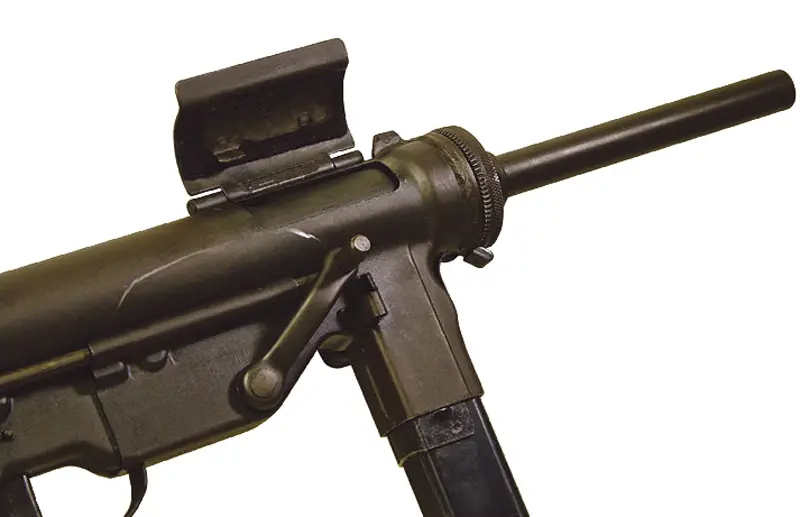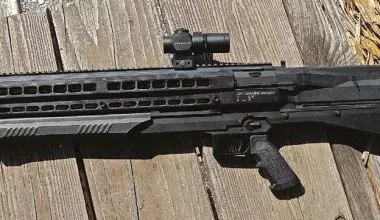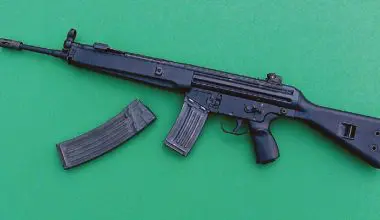I always find it interesting that the M3 SMG, which served in the U.S. armed forces for half a century, is so little known compared to other arms that had much shorter service lives. Designed to replace the expensive Thompson submachine gun (SMG) with one that was lighter and less expensive to produce, the M3 used steel stampings that were welded together for the receiver.
Other design features included a firing pin in the bolt, twin guide rods for the recoil springs supported by the bolt, and a cold-swaged barrel. The M3 was not only designed for ease of production, but with tolerances that would allow it to keep operating in sandy, muddy, or dusty conditions.

The German MP40 and British Sten SMGs influenced the M3’s design. However, unlike those two weapons, the M3 was intended to fire the .45 ACP round, though prototypes chambered for the .30 Carbine round were also built.
Although the original design allowed for select-fire, the M3 as adopted would fire only on full-auto. During testing and when initially issued in the field, various problems arose with the M3, including feed problems with the magazines, problems with the crank lever cocking handle failing, and a rear sight that was easily bent, among others.
No changes were made to the magazines, though a Tenite cap to keep out debris was adopted, but the other problems were addressed.

Based on various requests for improvements to the M3, the M3A1 model was introduced in December 1944 as a simplified and improved version of the M3. Of the total of 622,163 M3 SMGs produced during World War II by the Guide Lamp Factory of GM, only 15,469 were M3A1s. However, during the Korean War, Ithaca Gun Company produced about 33,000 more M3A1s.
The most noticeable difference between the M3 and M3A1 was the elimination of the crank-style cocking handle of the M3 for a cut in the bolt that let the weapon be cocked by inserting the finger in the cut.

Other changes allowed the bolt and guide rod group of the M3A1 to be removed from the receiver more readily. Finally, a magazine loading tool was incorporated into the M3A1 stock. This was very useful, as M3 magazines are very difficult to load without a tool. Both versions use the dust cover/safety, which is simple but effective.
Two variations of the M3 were made for the OSS. In one, the weapon was chambered for 9mm Parabellum, since this cartridge would be easier to acquire in occupied countries than the .45 ACP. Because Sten guns had been widely dropped to Resistance fighters, this version was adapted to take Sten magazines.
In addition to the 1,000 9mm M3s manufactured by Guide Lamp, another 500 or so conversion kits to switch an M3 from .45 ACP to 9mm were built by Rock Island Arsenal and Buffalo Arms Corporation.
Also for the OSS, Bell Labs developed a version of the M3 that used an integral suppressor. Suppressed barrels could screw on very quickly to replace the standard M3 barrel. Around 1,000 of the suppressed M3s were reportedly produced.
M3 SMGs began to be issued in 1944 and saw combat during the last months of the war. Paratroopers of the 17th Airborne Division carried M3 SMGs during Operation Varsity, the 24 March 1945 jump across the Rhine River.
From what I’ve read, there was some disagreement among airborne troops about whether they preferred the M3 or the M1A1 paratroop carbine. With stock folded, the M1A1 was 25.5 inches overall, while with stock collapsed, the M3 was only 22.8 inches overall.
The M1A1 and the .30 Carbine round were more accurate at longer ranges, but fans of the M3 argued that the heavy .45 ACP bullet gave better close-range knockdown power than the .30 M1 Carbine round.
For most World War II paratroopers, the only magazine available for the M1A1 was the 15-round version, while the M3 had a 30-round magazine. There was also the fact that the M1A1 Carbine was a semi-auto, while the M3 fired on full-auto.
The niche that the M3 filled especially well was as a weapon for armored crewmen. During the earlier part of WWII, U.S. armored crewmen normally had a Thompson SMG in their vehicle as well as their 1911 pistols. The M3 fit inside the crew area of the armored vehicles easily and could be removed and brought into action more readily if the crew had to leave the tank. M3s would remain in use with U.S. armored crews until the 1990s.
Other users of the M3 included truck drivers and MPs. During the Korean and Vietnam Wars, some special ops personnel, including LRRPs and USMC Recon, also used the M3. It saw some use with Special Forces as well, though SF used the Swedish K a lot. When Delta Force was first formed, their SMG was the M3 until contact with GSG-9 and the SAS resulted in its replacement by the MP5.
In considering U.S. military use, bear in mind that once the Thompson was phased out, the M3 was the only SMG readily available to U.S. troops until special units started purchasing HK MP5s in the 1980s and 1990s. But it was really the adoption of the M4 carbine that allowed replacement of the M3 in armored vehicles and for other users.
I’ve actually had less chance to shoot the M3 than many other SMGs, but recently a friend who has a registered one brought it to the range. I brought lots of .45 ACP ammo for the chance to reacquaint myself with the M3.
As I remembered, the rear peep and front blade sights are rudimentary. They’re regulated for 100 yards, but I find that optimistic, so I did most of my shooting at 25 yards on plates, at which distance the sights worked fine. I also did fairly well at 50 yards on short bursts.
Speaking of short bursts, the M3’s low cyclic rate—450 RPM—allows good control. Two- or three-round bursts are not difficult, and singles are possible with good trigger control.
Operating the crank handle was a bit difficult. I found the easiest method for me was to push the SMG hard against my shoulder with the support hand, while operating the handle with my shooting hand. The support hand grasps the contoured magazine well when shooting. Release of the magazine prior to a change was easy, because the release button is good sized and can be pressed as the magazine is grasped to pull it free.
My friend also had a spare suppressed barrel for his M3, so I released the lock on the barrel nut and unscrewed the standard barrel to replace it with the suppressed barrel. It did a good job of cutting noise, but the suppressed barrel was heavy enough that it was hard to hold the M3 on target for extended strings.
There are classic guns that I like to shoot simply because they are classic guns. Then there are guns that I like to shoot because they are still viable as well as being classics. I’d put the M1 Carbine in the latter category and the M3 Grease Gun in the former category.
Nevertheless, the next time my friend tells me he’s bringing the M3 to the range, I’ll scrounge some .45 ACP ammo so I can shoot it.





